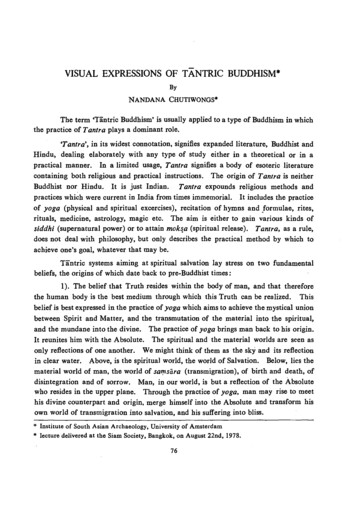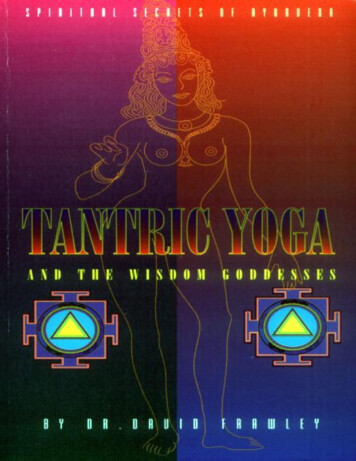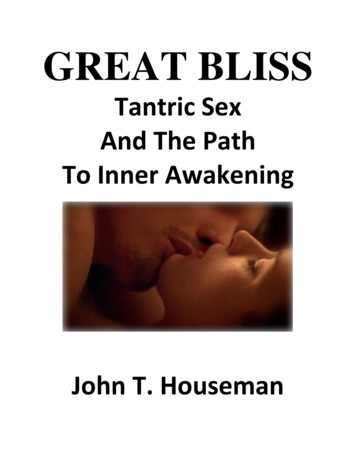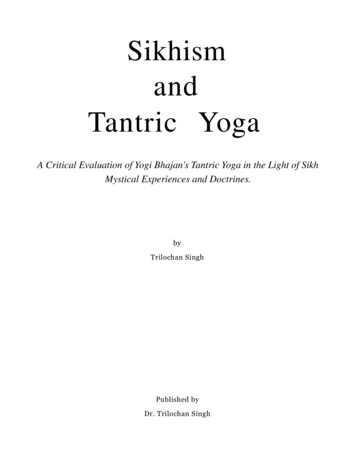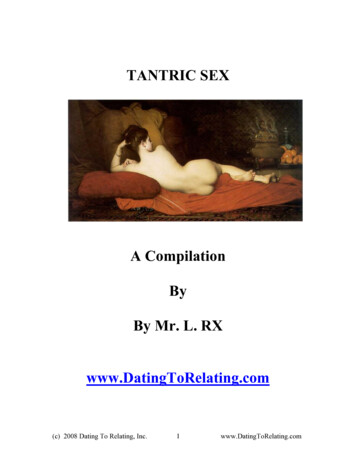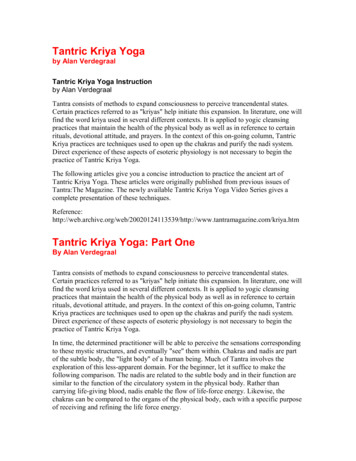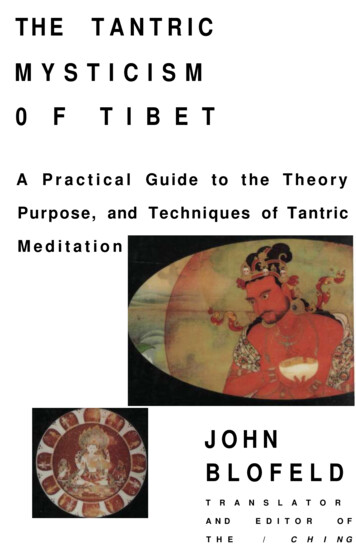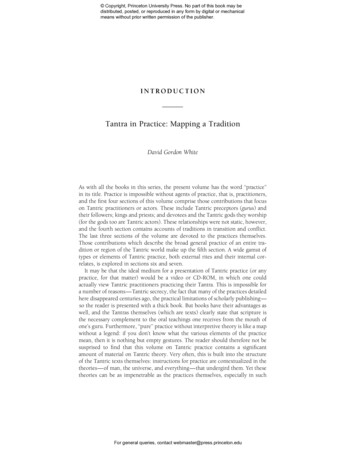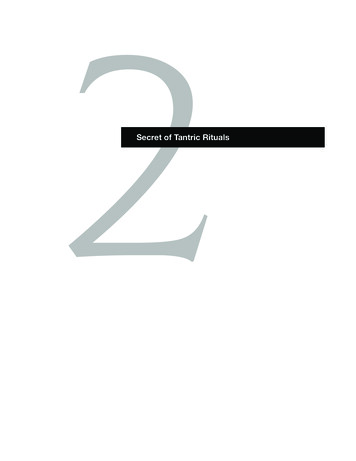
Transcription
2Secret of Tantric Rituals
Seminar Two — Secret of Tantric RitualsTable of ContentsIntroduction.2-1Lecture 1: Tantra and the Web of Life (Parts 1 and 2).2-3Outline.2-3Lecture Notes.2-5Study Questions.2-13Lecture 2: The Dynamics of Tantric Rituals (Parts 1 and 2).2-15Outline.2-15Lecture Notes.2-17Study Questions.2-25Lecture 3: The Tantric Way of Invoking the Forces of Nature.2-27Outline.2-27Lecture Notes.2-29Study Questions.2-33Lecture 4: The Tantric Method of Building a Sacred Fire.2-35Outline.2-35Lecture Notes.2-37Study Questions.2-41Lecture 5: The Dynamics of Sacred Fire (Parts 1 and 2).2-43Outline.2-43Lecture Notes.2-45Study Questions.2-55Lecture 6: Rudra Yaga—Tantric Rituals for Healing Ourselves andHealing the Planet (Parts 1 and 2).2-57Outline.2-57Lecture Notes.2-59Study Questions.2-71Secret of Tantric Rituals Bonus.2-7315 Questions on Secret of Tantric Rituals.2-73Extra Bonus Questions from Students of Tantra.2-75Secret of Tantric Rituals Resources.2-77Prana Dharana Practice.2-77Maha Mrityunjaya Mantra.2-79Secret of Tantric Rituals Practices Online.2-81Ritual Invocations and PrayersConstructing the Sarvato Bhadra YantraFire Ritual ManualPreparations for Fire RitualsLiving Tantra HavanTrikhanda and Samhara MudrasRecommended Reading.2-82Supporting Practices Online.2-82Living Tantra Guidebook
Seminar Two — Secret of Tantric RitualsIntroductionThis seminar explores the sacred nature of our body and the world around us. We’ll study thefundamental principles of tantric rituals involved in awakening both the subtle forces of our body,mind, and soul; and the mysterious forces contained in tantric rituals, mantras, yantras, andherbs. By understanding the basis of tantric rituals, we’ll see how they can awaken the subtleforces of nature and ward off obstacles that obstruct our progress in fully experiencing the joy ofwho we are. Tantric rituals can help us create a sacred space within us and outside us, creatingthe conditions for our spiritual and worldly endeavors to bear fruit quickly and effectively.At a practical level, we’ll learn how to build a sacred fire, select and combine ritual ingredients,apply appropriate mantras, and infuse the entire ritual practice with the inner fire that resides atour manipura chakra (the navel center). We’ll explore the mystery of both the inner fire, whichleads to personal empowerment and inner awakening, and the sacred fire, which leads to theempowerment of collective consciousness and the healing of our natural world.The theoretical and practical information in this seminar provides the foundation for the followingseminars in the Living Tantra series, particularly seminar three: Forbidden Tantra.Living Tantra Guidebook2-1
Seminar Two — Secret of Tantric RitualsLecture 1: Tantra and the Web of Life (Parts 1 and 2)Outline1. Summary of first seminar, Tantric Tradition and Techniquesa. Success in life’s endeavors and in spiritual practice requires inner strength and vitalityb. How Tantra empowers personal transformation2. Tantric understanding of the relationship between our vitality and the forces of naturea. How rituals help us nurture the natural world and be nurtured in turnb. Using rituals to benefit from the gifts of our natural environmentc. Story of how Earth was burdened and contaminated, and how it was saved by theboar incarnation of Vishnu3. Realizing our connection with the world around us and our mutual interconnectednessa. Story of a practice showing interconnectedness of allb. Need to protect ourselves from negativityc. Story of snakes in Allahabad illustrating ritual as communication across speciesd. Finding freedom in the world, not from the world4. Essence of tantric rituals is gaining access to the force of nurturance and healing and tothe whole web of lifea. Must understand the relationship of vitality in us and in the forces of nature thatnurture us: soil, air, water, plantsb. Proper performance of rituals is communication with different aspects of nature5. Understanding the power of mantra in ritualsa. Sound is the unique quality and characteristic that defines spaceb. Sound pollution is the most subtle and long-lasting pollution; nature of sound pollutionc. Much of efficacy of rituals depends on use of mantrad. Importance of maintaining purity of atmosphere and thoughts and speech for ritualsLiving Tantra Guidebook2-3
Seminar Two — Secret of Tantric Rituals6. How impurities accumulate in the body and mind according to Ayurvedaa. Psychological and physical conditions regulated by the first three chakras aremost susceptible to impurityb. Formation of ama—impurities, source of illness, and toxinsc. Different sources of amad. Improperly processed emotions affect doshas (constitutional qualities)e. How symptoms appear not only in our bodies but also in the outside worldf.2-4Tantric rituals as a means to restore balance within and withoutLiving Tantra Guidebook
Seminar Two — Secret of Tantric RitualsLecture NotesSummary of Tantric Tradition and Techniques Success in life’s endeavors and in spiritual practice requires inner strength and vitality. Awakening prana shakti results in vigor, self-confidence, motivation, and insight, andthis is what is needed for success in any endeavor, worldly or spiritual. This is the“enlivening” discussed in the first seminar, Tantric Tradition and Techniques, andneeded for tantric rituals. The basic prerequisite for tantric rituals is to intensify, refine, and direct pranic shakti.Then infuse all other practices and disciplines with that pranic shakti. This is how Tantraempowers you in personal transformation.Tantric Understanding of the Relationship Between Our Vitality andthe Forces of Nature Rituals are the external counterpart of the yogic practices which access energy centers inthe body. Just as we concentrate pranic shakti with prana dharana at the navel center, andlearn to take advantage of the vitality at this center, so with rituals we will breathe life intonature’s forces and learn to use them. Rituals help connect us to the subtle forces of nature and arrange them in our favor. If we nurture the forces of nature, they nurture us. This is a fundamental truth in tantricpractice: Story of how Earth was burdened with filth and contamination. The presidingforce of Earth tries to heal it, but finally invokes the fundamental source of healing,nurturance, and maintenance—Lord Vishnu. Vishnu is the all-pervading force of kundalini shakti. His bed is a serpent namedShesha, one who never dies. Vishnu sleeps in yoga nidra. He is the Preserver.Living Tantra Guidebook2-5
Seminar Two — Secret of Tantric Rituals Earth’s prayers to Vishnu caught the attention of Brahma, the Creator.From his exhalation is born Varaha Avatara—the boar incarnation of Vishnu—whose body is made of wisdom. Varaha circumambulates Earth and plunges into the ocean. The splash washesover the land. Millions of boars like Varaha emerge from the splash and roam overEarth devouring garbage and jumping into water to cleanse themselves. Finally theecology of the planet comes back into balance. Lessons from this story: Earth is a living planet, imbued with intelligence; it suffers when treated asa commodity. Earth becomes imbalanced when human beings feel entitled to ownit and its resources; and justify their greed, selfishness, andpossessiveness. Because of distorted understanding, there is no enforcement of law and orderin society to support and protect the rest of creation, and nature is thus leftunattended by higher intelligence.Realizing Our Connection with the World Around Us and Our MutualInterconnectedness All spiritual traditions of India share the view that all life and nature are part of one whole: Example from the first verse of the Isha Upanishad: “Everything is made ofIsha, everything exists in Isha, everything is meant for Isha.” Isha is that whichpervades and permeates everything; and manifests in the sun, the moon, in youand in everyone and everything. This realization is at the core of any spiritual growth and development. Panditji’s personal experiences of this underlying connection and unity: The neti, neti (“not this, not this”) practice—self-reflection on thoughts, speech, andactions to dis-identify with ingrained, limited self-identifications: “I’m not a man;2-6Living Tantra Guidebook
Seminar Two — Secret of Tantric Rituals I’m not a woman; I’m not Hindu; I’m not Christian”; etc. After 90 days, the oppositepractice: “I’m a man; I’m a woman; I’m Hindu; I’m Christian; all forms, shapes, andnames, natural or man-made, are saturated with my inner consciousness.” After this practice, he experienced sadness and questioned his teacher, SwamiRama. Swamiji explained, “The reason lies in the way this practice (pranavasadhana) is done. After prana dharana at the ajna chakra (see Tantric Tradition andTechniques), you establish Om there and bring it to the crown chakra (sahasrasarachakra). Om flows with the inhale and exhale, and because of the “I am everything”contemplation and the pranic connection, you are connecting yourself to thecollective consciousness. Billions of people are living in misery. Thus youexperience the misery of the collective consciousness.” We must learn to protect ourselves from negative influences, and yet realize theinterconnected nature of everything. Tantra tells us how to do this: Without seeing yourself as an integral part of the vast web of nature, youremain spiritually poor, and inner poverty reflects into the world around you,making you a source of misery to yourself and others. To experience the integration and yet be protected from the negative,Swami Rama explains, “In meditation visualize yourself as a complete entityalthough fully connected with everything.” You are a finite vessel in theocean of infinity. Protect and nurture the finite vessel of the body and mindso it is strong, clear, and confident; reside in the infinite pool of non-duality. Another example of a spiritual practice connecting to the subtle forces of nature: Panditji and his family recited a set of mantras dedicated to the thousandforms of Rudra, the life force, and humbly requested the cobras infestingthe Institute’s land in Allahabad, India, to leave the premises and make roomfor the Institute. A few months later, no snakes were to be found anywhere.Living Tantra Guidebook2-7
Seminar Two — Secret of Tantric Rituals Human beings, animals, plants, rivers, mountains—all are infused withconsciousness and prana shakti. But they don’t understand each others language: A new reality is created when the interconnection of all is realized. Exampleof creating new situations when you meet and can communicate withsomeone from a different culture. The mutual language of all is the language of the heart, which allows you tofeel each other’s presence and importance. This is the realm of Tantra, andthe foundation of tantric rituals. The Spirit of Tantra: Realizing our perfection and fulfillment contributes to the perfection andfulfillment of others, and vice versa. Skillfully using everything inside and outside of us for the mutual benefit of all. Then our mutual interconnectedness and dependency becomes a sourceof freedom, not of bondage, and gives us freedom in the world, not fromthe world.Essence of Tantric Rituals is Gaining Access to the Force of Nurturanceand Healing and to the Whole Web of Life Need to understand the relationship of vitality in us and in the forces of nature that nurtureus: soil, air, water, plants. Example of dogs on Allahabad campus. When the staff stopped beating them, all the dogsin the whole area stopped crying at night in response to the howling of the jackals, andstarted barking instead (a normal response). Dhuti vijnana is the science of reading signs in nature, and understanding messages aboutthe health and well-being of your surroundings. Jackals, ants, crows, and other birds areparticularly good messengers.2-8Living Tantra Guidebook
Seminar Two — Secret of Tantric Rituals Example of solar eclipse at Vindhyachal: temperature dropped, wind came up; and birdsand monkeys exhibited confused, uncharacteristic behavior because the normal law andorder of nature was disturbed. Proper performance of rituals is like communicating with different aspects of nature.Understanding the Power of Mantra in Rituals Tantric practitioner Bhuta Baba’s unique description of “human”—one not bound byanger, greed, lust, etc.; whose actions are not propelled by instinctive urges. Bhuta Baba explains how sound is the unique quality and characteristic that definesspace. The sound principle is the most subtle of all, and from it evolves mantra andlanguage: If inauspicious sounds fill space, that is the most serious kind of pollution with themost long-lasting impact on the whole of creation. The meaning and feeling behindsound creates a subtle reality which is a product of our thoughts, and which can’tbe recalled. Control over the tongue is important for concentrating our inner power and energy. Animpure tongue is an expression of impure thoughts which pollute the mind and heart.Energy gained from rituals is consumed and neutralized by impure thoughts and speech,making it difficult to see the fruits of the practice. Much of the efficacy of rituals depends on how we speak, and the use of mantra.The science of mantra is part of how we breathe life into rituals.Living Tantra Guidebook2-9
mūlādhārama ipūraSeminar Two — Secret of Tantric Rituals svādi hānaanāhata toHow Impurities Accumulate in the Body and Mind Accordingma ipūraviśuddhimūlādhāraAyurveda by the first three In the body, the psychological and physical aspects of being regulated chakras are the most susceptible to impurity: anāhataājñāsvādi hāna viśuddhisahasrāra ma ipūramūlādhāra ājñā anāhatasvādi hāna sahasrāra viśuddhimūlādhārama ipūra ājñā svādi hānaanāhata mūlādhāra sahasrāra ma ipūraviśuddhiChakras in the Subtle Body Impurities are ama, which occurs in three stages: svādi hāna anāhata ājñā mūlādhāra ma ipūra viśuddhi sahasrāra svādi hānaanāhata ājñā a. Sanchaya—the accumulation of impurities from food, air, water; and also fromthoughts, speech, actions and interactions. ma ipūraviśuddhi b. Prasara—the movement of impurities which erupt in asahasrāra weak spot in the anāhatasystem, e.g., the lungs, or the skin. If ama is removed at this stage by theājñāprocess of prashama, or calming, disease process is halted. viśuddhic. Prakopa—the aggravation and manifestation of dysfunction or illness.2-10sahasrāra Living Tantra Guidebook ājñā
Seminar Two — Secret of Tantric Rituals Food-related ama accumulates in the digestive system. Breath-related amaaccumulates in the lungs and blood. Sleep-related ama accumulates in theendocrine system. Relationship- and thought-related ama accumulate in thebrain and nervous system. Example of eating bad food. If body manages to process it and eliminate thetoxins, it doesn’t cause illness. But if you can’t process it, it becomes prakopa,and manifests as some illness. Mental, emotional toxins, such as anger, repressed thoughts, conflicts, and unfulfilleddesires, derange doshas, depending on the type of emotion: attachment and delusionaggravate kapha; anger pushes pitta; and worry and fear aggravate vata. If one dosha isdisturbed, the others are also affected—they support each other and are intermingled. Aggravated doshas affect the systems governed by the first three chakras. Mental behavior affects the purity of the heart; and strongly affects the first threechakras. If the desire to possess and consume is stronger than common sense, there is a negativeimpact on the energies of the first three chakras and the organs residing in their domain,and the negative impact will appear not only in our bodies, but also in the outside world. Law and order in the outer world begins to disintegrate when intended relationshipsbetween different aspects of nature, like human beings and animals, are disturbed.The subtle governing forces of nature are disrupted. Unhealthy conflict between desire to own, consume, possess, and not wanting others tohave the same comforts and conveniences if their viewpoints are not the same as ours;unhealthy conflict between ourselves and nature; between ourselves and those who aredifferent from us. Perennial disease of the human race: confusion over right and wrong, just and unjust; andit predisposes us to illnesses related to the first three chakras.Living Tantra Guidebook2-11
Seminar Two — Secret of Tantric Rituals Tantric rituals are the means to restore balance within and without. Tantric philosophyovercomes confusion. In the short term, we need yogically inspired tantric techniques, ortantrically inspired ritual techniques, to heal the first three chakras. First chakra: fear, insecurity, doubt, sloth. Second chakra: desire, conflict, attachment, killing the conscience. Third chakra: power, possession, position, prestige. Tantric rituals are designed to help the concerns of these three chakras, and to bring us tothe love at the heart center (anahata chakra) and the clarity of mind at the eyebrow center(ajna chakra).2-12Living Tantra Guidebook
Seminar Two — Secret of Tantric RitualsStudy Questions:01. What is the purpose of tantric rituals?02. Does the world today resemble Earth at the time of Varaha’s incarnation?03. Does the prevailing worldview conform with the tantric perspective?04. Do you see any evidence of changes in perspective in the world at large with regardto the environment?05. With regard to global warming, what kinds of solutions would a tantric worldview reject,and what kinds of solutions would arise from a tantric perspective?06. Why are the ingredients and tools used in rituals important?07. What is the foundation of tantric rituals?08. What difficulties must be overcome to perform tantric rituals effectively?09. What is the nature of the thoughts and words we are collectively broadcastingthroughout the world today? Consider the content broadcast through radio, television,and the internet.10. Why is it important to maintain purity of thought and speech when conducting rituals,or doing practice?11. How is Ayurveda related to yoga philosophy?12. What is ama and what are the pathways for its accumulation?13. Why do you think the pelvic energy centers are so easily disturbed and contaminated?Consider Bhuta Baba’s description of a “human.”Living Tantra Guidebook2-13
Seminar Two — Secret of Tantric RitualsLecture 2: The Dynamics of Tantric Rituals (Parts 1 and 2)Outline1. Fundamental difference between a ceremony and a tantric rituala. Differences between tantric ritual and ceremonyb. Example of recent war protests and Gandhi’s salt marchc. Rituals need concentrated energy, focus, and understanding2. Understanding the anatomy of ritualsa. Knowing what you want to achieve and whyb. Determination and concentration of energy are essential for successc. Knowing the proper means, tools, and ingredientsd. Breathe life into the ritual with prana dharana3. Proper communication with the forces of interesta. The subtle world is unfamiliar; we infer its existence, but usually do not experience itdirectly, and there is existence at an even more subtle level than our inferenceb. Rituals are designed to reach the presiding force, the essence itself4. The tantric concept of apurva: giving birth to a new reality through tantric rituals, andreshaping our destinya. Understanding goals: worldly or spiritual, and focusing goalsb. Steps in apurva: having a plan of action and the implementation of the plan5. How apurva works in accordance with the law of karma and how tantric ritualscreate apurvaa. Groups of similar karmas are stored together in a karmashaya—a package of karmab. The fruits of the broad categories of pleasant and painful past karmas are connectedto our overall destiny and result in our current birthLiving Tantra Guidebook2-15
Seminar Two — Secret of Tantric Rituals6. Tantric rituals create a karmashaya, which may counter a particular habit or problema. Punya karmashaya—virtuous, precise, and focused karma created by a tantric ritualb. Punya karmashaya can change a troublesome inclination or habit by creating a newreality that is independent of past karmasc. This is how tantric rituals create apurva—a new, desirable, concentrated reality thathas the power to ensure that past actions bear fruit in accordance with your planin the future7. The main components of tantric ritualsa. Precise procedure, clear intention, unwavering faith, correct ritual ingredients, properway of invoking the divinities, building a fire correctly, and channeling the energyengendered by ritual to the right place at the right timeb. In tantric rituals, mantra, yantra, visualization, and fire offerings are the main forces—the factors which fortify the rest of the ritual procedure and processes and awakenthe dormant force of the herbs, gems, or ritual materials2-16Living Tantra Guidebook
Seminar Two — Secret of Tantric RitualsLecture NotesThe Fundamental Difference Between a Ceremony and a Tantric Ritual The protest of war with Iraq involved millions of people, but they were expressing theiropinion, and their protest was not focused enough to make a difference; they went backto their normal life at the end of the day. Mahatma Gandhi’s salt march protest is an example of action with intense determination,clarity, focus, and understanding, which made a difference. Similarly, a ritual has this deep level of understanding and intense concentration ofenergy. It is not expressing a desire or opinion; it is not symbolic; it is not cultural orcustom-driven. A ritual is methodical and energetically concentrated. Another example given is of the heat in a room. If you compress all the heat in the roominto a small space it is very hot and will boil water and cook your rice; or if further concentrated, it will weld metal; but if it is diffused in the room, it will never cook your rice.Understanding the Anatomy of Rituals Rituals are purpose-driven and well-planned. They require the appropriate tools andmeans and ingredients: Example of how transportation by land and transportation by air need differentvehicles. The energy is the same, but the means must be different. The nature of your goals and objectives and the space, time, and kind of society orindividual you are all factor in the ingredients and means used for the ritual. First, you must understand what you are trying to do and why: Understand what is required in order to do what you want to achieve. Example oftrying to move a chair without using the appropriate force. You could spend muchenergy over 20 years without overcoming the initial inertia in the chair.Living Tantra Guidebook2-17
Seminar Two — Secret of Tantric Rituals Another example of jogging—the first 5 minutes just warms up the muscles; onlyafter 15 minutes or more does the metabolic rate change and the benefits accrue.And you must exercise again the next day, because this is the way the body isdesigned. Rituals are directed either to personal unfoldment, empowerment, andenlightenment; or they are directed toward the well-being of others, ofnature, or the society or environment. Second, intensity, force, willpower and determination are needed for rituals: Prana dharana can be done internally to concentrate this energy. Prana dharana can also be done by the ritualistic method using pranapratishtha and mantras, yantras, herbs, and other tools. Only after life has been breathed into the physical components of rituals dosuch rituals of sprinkling water, ringing bells, etc., have any power. The yogic style of prana dharana was studied in the first seminar, TantricTradition and Techniques, and breathes life into our own body, mind,senses, thoughts, speech, and actions. It involves concentrating the pranicforce at the navel center and then transporting it into the different partsof the body, or into mantras, yantras, or deities, or into our ritual. Pranapratishtha is breathing life into a locus, in this case, the ritual itself.Proper Communication with the Forces of Interest We can communicate with that which we know and understand: Example of not being able to speak the language of another culture, though wewould like to conduct business with them. We are familiar with the material world and have trained the senses and mind tounderstand it; but we have a hard time understanding anything outside the domain2-18Living Tantra Guidebook
Seminar Two — Secret of Tantric Rituals of our perception. So we have extended our perception through tools likemicroscopes and telescopes to expand our understanding. We infer existence and understanding of some phenomena through observationand reasoning. Another level of reality exists beyond inference and the experience of the material world: This extremely subtle force is the guiding, presiding essence of something—amountain, a person, turmeric, garlic—whatever makes it what it is and propels itsactions: its essence, its definitive quality. This is the divinity, according to tantrics. In humans, this inner divinity is what propels our thoughts, speech, and action, andguides and governs the power of will, the power of knowledge, and the power ofaction. That same inner divinity may be regarded as a devil from some perspectives.Example of Kamadeva versus Manmatha. It is the same force, but is seen asManmatha—the churner of the mind, a problem maker—by non-tantrics, while fortantrics Manmatha is Kamadeva—the primordial master who sits deep in the caveof our heart and drives the chariot of life to its destination. He is the spirit of gurushakti, the seer of the Sri Vidya mantra, and the teacher and primordial master ofthe most exalted yantra of the tantric tradition, the Sri Chakra. Examples of inner essence using garlic, turmeric, and artificial food. Rituals are designed to reach and convey a message to that presiding force, that rulingdivinity, of whatever is the object of the ritual. With ritual, you communicate with the essence of something, the presiding force,the inner divinity, in its language: you must first identify the inner d
needed for tantric rituals. The basic prerequisite for tantric rituals is to intensify, refine, and direct pranic shakti. Then infuse all other practices and disciplines with that pranic shakti. This is how Tantra empowers you in personal transformation. Tantric Understanding of the Relationship Between Our Vitality and the Forces of Nature

